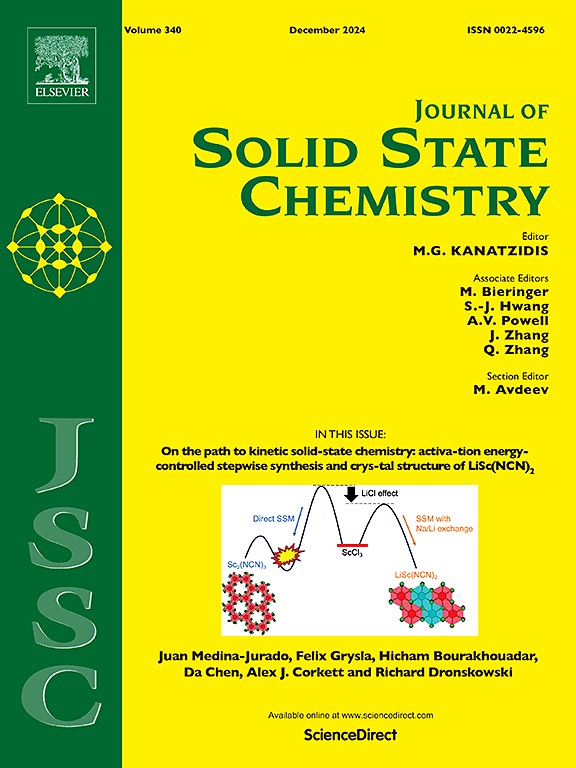Three organic−inorganic hybrid chlorides based on pyrazine-bridged bisimidazoly cation: crystal structures, luminescent sensor and photoelectric properties
IF 3.2
3区 化学
Q2 CHEMISTRY, INORGANIC & NUCLEAR
引用次数: 0
Abstract
Organic−inorganic hybrid halides have attracted great attention because of their outstanding photoelectric properties. Using appropriate organic and inorganic metal halide components, organic−inorganic hybrid halides with controlled dimensionalities at the molecular level can be obtained. In this study, three new hybrid chlorides, [H2bimpz]0.5[PbCl3] (1), [H2bimpz][BiCl5] (2) and [H2bimpz][SbCl5] (3) [2,5-bis(N-imidazolyl)-pyazine, bimpz], were synthesized and crystallographically characterized. Compound 1 consists of a one-dimensional chain structured by tetragonal [PbCl5]3- units. Compound 2 features a binuclear [Bi2Cl10]4- cluster linked by two [BiCl5]2- through edge-sharing. Compound 3 exhibits a distorted five-coordinated mononuclear [SbCl5]2- anion. Both 1 and 3 exhibit a trans-conformation in [H2bimpz]2+ while 2 adopts a cis-conformation. 1 presents a band gap of 3.28 eV, while both 2 and 3 show energy band gap of approximately 3.09 eV. 3 displays the potential as a luminescent sensor for Cr2O72− ions with a limit of detection 1.52 × 10−8 M. Moreover, the photocurrent response follows the order: 3 > 1 ≫ 2, which demonstrates the photoelectric properties are attributed to the synergistic effect of the short interactions between anions and cations and π‧‧‧π interactions.

三种基于吡嗪桥接双咪唑阳离子的有机-无机杂化氯化物:晶体结构、发光传感器和光电性能
有机-无机杂化卤化物因其优异的光电性能而受到广泛关注。采用适当的有机和无机金属卤化物成分,可以得到在分子水平上具有可控尺寸的有机-无机杂化卤化物。本文合成了[H2bimpz]0.5[PbCl3](1)、[H2bimpz][BiCl5](2)和[H2bimpz][SbCl5](3)[2,5-双(n -咪唑基)嘧啶,bimpz] 3种新型杂化氯化物,并进行了晶体表征。化合物1由一个由四方[PbCl5]3-单元构成的一维链组成。化合物2具有一个双核[Bi2Cl10]4-簇,由两个[BiCl5]2-通共用边连接。化合物3是一个扭曲的五配位单核[SbCl5]2-阴离子。1和3在[H2bimpz]2+中呈反式构象,而2呈顺式构象。1的能带隙为3.28 eV,而2和3的能带隙均约为3.09 eV。3显示了作为Cr2O72−离子发光传感器的潜力,检测限为1.52 × 10−8 m,光电流响应顺序为:3 >;1 > 2,表明其光电性质是由阴离子与阳离子之间的短相互作用和π··π相互作用的协同效应所决定的。
本文章由计算机程序翻译,如有差异,请以英文原文为准。
求助全文
约1分钟内获得全文
求助全文
来源期刊

Journal of Solid State Chemistry
化学-无机化学与核化学
CiteScore
6.00
自引率
9.10%
发文量
848
审稿时长
25 days
期刊介绍:
Covering major developments in the field of solid state chemistry and related areas such as ceramics and amorphous materials, the Journal of Solid State Chemistry features studies of chemical, structural, thermodynamic, electronic, magnetic, and optical properties and processes in solids.
 求助内容:
求助内容: 应助结果提醒方式:
应助结果提醒方式:


